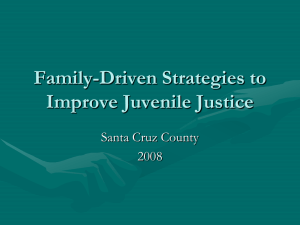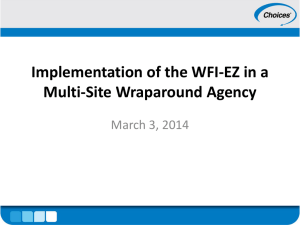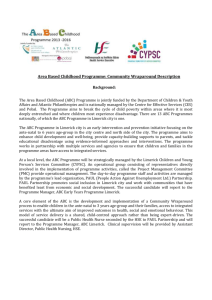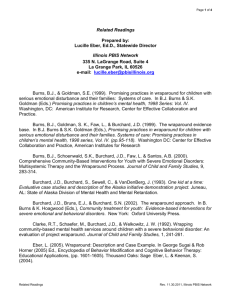As a services researcher privileged to have spent much of his career
advertisement
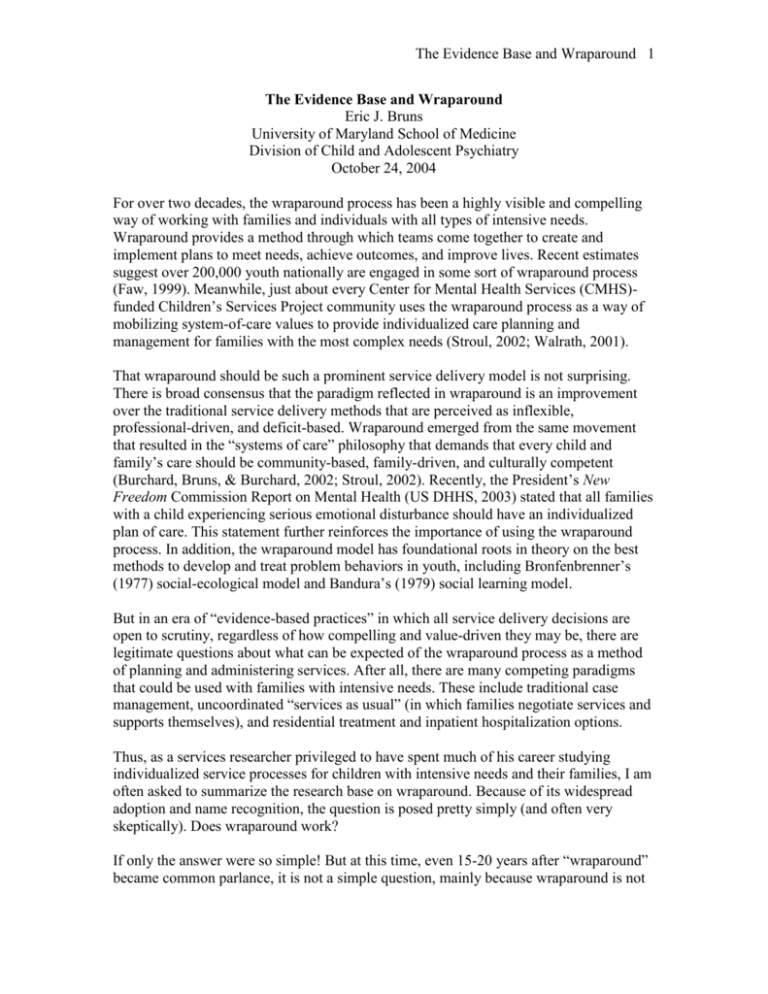
The Evidence Base and Wraparound 1 The Evidence Base and Wraparound Eric J. Bruns University of Maryland School of Medicine Division of Child and Adolescent Psychiatry October 24, 2004 For over two decades, the wraparound process has been a highly visible and compelling way of working with families and individuals with all types of intensive needs. Wraparound provides a method through which teams come together to create and implement plans to meet needs, achieve outcomes, and improve lives. Recent estimates suggest over 200,000 youth nationally are engaged in some sort of wraparound process (Faw, 1999). Meanwhile, just about every Center for Mental Health Services (CMHS)funded Children’s Services Project community uses the wraparound process as a way of mobilizing system-of-care values to provide individualized care planning and management for families with the most complex needs (Stroul, 2002; Walrath, 2001). That wraparound should be such a prominent service delivery model is not surprising. There is broad consensus that the paradigm reflected in wraparound is an improvement over the traditional service delivery methods that are perceived as inflexible, professional-driven, and deficit-based. Wraparound emerged from the same movement that resulted in the “systems of care” philosophy that demands that every child and family’s care should be community-based, family-driven, and culturally competent (Burchard, Bruns, & Burchard, 2002; Stroul, 2002). Recently, the President’s New Freedom Commission Report on Mental Health (US DHHS, 2003) stated that all families with a child experiencing serious emotional disturbance should have an individualized plan of care. This statement further reinforces the importance of using the wraparound process. In addition, the wraparound model has foundational roots in theory on the best methods to develop and treat problem behaviors in youth, including Bronfenbrenner’s (1977) social-ecological model and Bandura’s (1979) social learning model. But in an era of “evidence-based practices” in which all service delivery decisions are open to scrutiny, regardless of how compelling and value-driven they may be, there are legitimate questions about what can be expected of the wraparound process as a method of planning and administering services. After all, there are many competing paradigms that could be used with families with intensive needs. These include traditional case management, uncoordinated “services as usual” (in which families negotiate services and supports themselves), and residential treatment and inpatient hospitalization options. Thus, as a services researcher privileged to have spent much of his career studying individualized service processes for children with intensive needs and their families, I am often asked to summarize the research base on wraparound. Because of its widespread adoption and name recognition, the question is posed pretty simply (and often very skeptically). Does wraparound work? If only the answer were so simple! But at this time, even 15-20 years after “wraparound” became common parlance, it is not a simple question, mainly because wraparound is not The Evidence Base and Wraparound 2 a simple phenomenon. Wraparound was not created, pilot tested, and manualized by a single team of practitioners or researchers. Nor is it aimed at remediating a single type of problem, let alone addressing a single diagnosis. Wraparound has been an evolving and “grassroots” movement, it is multi-faceted and individualized, and it is usually deployed for families with complex and overlapping needs, not a single problem area or diagnostic category. And because there are so many variations of “wraparound” and so many ways in which this value-based process may be administered from community to community, the question “Does wraparound work?” has been difficult to answer. Thus, when asked about “The evidence base on wraparound,” I prefer to instead consider “The evidence base and wraparound.” This is a more complicated (and interesting) story that better fits the complex history of the model and the families it is intended to help. Here are some major themes from that story: 1. Despite some successes in building an evidence base for success, we have made limited progress in finding treatments that work in the “real world” for children with complex needs. This underscores the importance of using family-driven and individualized service processes. Like “wraparound,” the “science to service” gap in children’s mental health and other fields is becoming common parlance among researchers and service providers. Research is consistently finding significant impact of treatments for children and youth under controlled conditions, such as laboratory studies where clinicians have low caseloads and intensive supervision and the children or youth have a single problem. However, when these treatments are administered in actual community settings, they don’t usually yield good outcomes. Similarly, studies of “systems of care,” such as the Fort Bragg and Stark County studies, have suggested that merely improving the amount of available services or the coordination across systems is not likely to improve actual outcomes for families (Bickman et al, 2000). There have been many interpretations of these problematic findings. One prominent interpretation is that clinical services in “real world” communities are not delivered in a way that can achieve positive clinical outcomes. However, research also demonstrates other problems. First, families are rarely well-engaged with their helping professionals. Second, care is not well-tailored to the full range of families’ needs. Researchers point to such lack of full engagement and individualization to explain why families often feel the care they receive is not relevant or helpful. This also may explain why 60-75% of families drop out of treatment prematurely (Kazdin, 1996; Owens et al., 2001). Meanwhile, other studies illuminate just how difficult it is to implement treatments that are evidence based. The highly influential Multi-modal Treatment of ADHD (MTA) study has shown that, even under controlled conditions, treatment for families with children with overlapping and complex problems or stressors such as low income levels are far less successful than for families with children with only one diagnosed disorder or The Evidence Base and Wraparound 3 fewer stressors (Jensen, 2004). The MTA study also shows that families with children with more complex needs are more likely to benefit from multiple treatments used in combination (e.g., both medication as well as psychosocial treatments). This suggests that these families – who are more likely to resemble families with children described as having a “serious emotional disorder” – require more holistic, individualized, and tailored care. Meanwhile, an interesting study of one of the few evidence-based integrated treatments for children with behavioral disorders – multisystemic therapy or MST (Henggeler et al, 1998) – suggests that delivering EBPs in an individualized and family-driven manner may be very important. This study found that one principle of MST – that clinicians are highly directive of treatment – actually was associated with poorer outcomes in families if the family was not fully engaged with the therapist (Huey et al, 2000). Thus, it seems that even when administering an evidence-based treatment such as MST, tailoring care to parents’ expressed needs and achieving full engagement is highly important, perhaps as important as adhering to treatment protocols. Our interpretation of this broad set of findings is that the heralded “science to service gap” is at least partly due to systems not supporting full engagement of families in the treatments they receive. For families with intensive needs or children with serious emotional and behavioral problems, such full engagement will usually require the creation of highly individualized and creative plans of care that address multiple issues confronted by the family. What’s more, such plans will need to fully interact with the needs expressed by the family. A well-implemented wraparound process provides for procedures to accomplish this for families with these most intensive needs. Thus, it is important that research on overcoming the “science to service gap” considers how the wraparound process might be employed to improve outcomes in “real world” community settings. In a similar vein, researchers, advocates, and practitioners must be careful not to pose as incommensurate families participating in a wraparound process, while also receiving specific treatments (including evidence based treatments) that might be part of their individualized plan of care.1 The two are highly compatible; after all, the intent of the wraparound process is to plan and implement the set of services and supports that is most likely to achieve positive outcomes for a family. For some families, this may involve administration of multiple formal treatments with scientific support for effectiveness. 2. The principles of wraparound are supported by evidence from the research base as well as common sense and social justice. As described above, the broad-based literature on children’s services suggests that the wraparound process holds promise for overcoming commonly-cited barriers to achieving outcomes for children and families. Additional evidence for wraparound’s potential for 1 This includes other complex treatment processes that are often grouped together with wraparound in descriptions of treatments options, such as MST or Multidimensional Treatment Foster Care (Chamberlain, 2002), both of which are considered evidence-based practices. The Evidence Base and Wraparound 4 impact can also be found by looking to the research literature for support for the 10 principles of wraparound (recently refined by the National Wraparound Initiative; see www.rtc.pdx.edu/nwi). Support for several of these principles is described below: We have already described how the wraparound principle of “family voice and choice” may be critical to achieving outcomes. As discussed above, lack of full family engagement has been found to be a major impediment to treatment implementation and some studies have found that therapist directiveness may be counterproductive if there is not a full alliance with the family. In addition, Heflinger et al. (1996) have created methods for better engaging families, studies on which have found that family members’ overcoming of negative experiences of past treatments received is critical to achieving engagement and possibly outcomes. Spoth & Redmond (2000) have found that family members’ belief in effectiveness of treatment influences engagement and outcomes. Finally, in an important study, Angold et al (1998) found that a family’s use of services and supports was not predicted by type or severity of child problems, but rather by parents’ own perception of stress and parenting strain. These findings provide support for the principles of prioritizing the family’s perceptions of what the family needs to function better. (They also support the wraparound principles stating that services and supports should be culturally competent and, wherever possible, unconditional in nature.) The research also supports wraparound’s requirement of a full engagement phase in which the family’s strengths and needs are well understood, parent preferences are specified for how collaborative work will be undertaken, and building of an alliance between providers and family members. Meanwhile, the wraparound principles of “team-based” and “collaborative” have clear support from research across disciplines. In the child services research field, Stone and Stone (1983) found that positive child outcomes were more likely to result when foster parents viewed themselves as part of a team with a goal of positive outcomes. Meanwhile, evaluations such as that conducted by Burns & Santos (1995) have found that team-based care for adults with serious mental illness was found to be superior than “brokered” case management models. Assertive Community Treatment (ACT; Bond et al., 2001), which uses a team-based approach to aid adults with SMI, has long been a standard for delivering quality care to this population. These results are not surprising – outside the services research world, organizational researchers have documented in many ways that effective teams succeed in generating far more options than individuals, leading for far more effective plans (e.g., Mesch, Farh, & Podsakoff, 1994; West et al, 1998). One of the signature principles of both wraparound and systems of care philosophy is that care is community based. Though honoring families’ desire to obtain support while keeping their children at home is a principle steeped in social justice, delivering care in the natural environment in which a child and family functions is also a principle grounded in theory and research. Bronfenbrenner’s and Bandura’s models stress that to be generalizable, behaviors must be taught in the environment in which they will be practiced. As such, these models underpin many evidence-based approaches to treatment The Evidence Base and Wraparound 5 (e.g., behavioral therapies and MST) that are intended to instill the teaching of skills, more adaptive responses by youth and their families, and positive outcomes. The basis for insisting on community-based treatment models wherever possible does not stop at theory. Many studies (e.g., Pfeiffer et al, 1990) have found that the best predictor of future out-of-home placements is past placements. Other studies show that both placement stability and youth perception of placement stability are significant predictors of future outcomes (Dubovitz et al., 1993; Horvitz et al., 1994). Meanwhile, the National Adolescent and Child Treatment Study found that, of youth successfully discharged from residential treatment placements, 33% were back in a restrictive placement within one year75% were placed in another restrictive setting at least once within the next 6 years (Greenbaum et al., 1996). Thus, assuming that we hope to ensure that young people will eventually live effectively in their home communities, we must strive to prevent all unnecessary out-of-home placements. This becomes especially important when we consider that we historically have spent a disproportionate amount of our child behavioral service dollars on residential and inpatient care, despite that this treatment approach has the most poorly developed research base of all major child and adolescent treatment options (Burns, Hoagwood, & Maultsby, 1998). Finally, theory and research both support the importance of individualized care for individuals with complex needs. This may explain why individualization is a cornerstone of the wraparound process and systems of care, and also why it is prominent among the President’s New Freedom report recommendations. Several influential psychosocial theories of child development, particularly social-ecological (Bronfenbrenner, 1979) and systems (Munger, 1998) theories, stresses the importance of understanding the unique relationships between the child and various environmental systems (e.g., family, school, community) as well as the relationships between such systems themselves (Walker et al., in press). Effective intervention thus begins from an understanding of the child’s unique social, cultural, and interpersonal systems environment, and the tailoring of services and supports to this unique set of relationships. Such theories may help explain findings from the MTA study described above (Jensen, 2004) showing that families with the most complex needs were likely to benefit the least from administration of a single evidencebased treatment and were the most likely to benefit from combinations of therapies. Meanwhile, literature on case management for adults with serious mental illnesses has been consistent in its support of more intensive and early tailoring of community supports to client needs (e.g., Ryan, Sherman, & Bogart, 1997). Studies of case management have also found that a greater variety of community-based supports leads to greater client satisfaction and retention in services (Burns et al, 1996). 3. Despite support for the wraparound philosophy, research also has demonstrated a “fidelity problem” in wraparound that is important to overcome. As described above, both theory and research support the principles of the wraparound process and its potential for impact. In the classic framework for developing a treatment model, theory and past research are prerequisites for moving forward with model development and tests of effectiveness. However, in the case of wraparound, such The Evidence Base and Wraparound 6 empirical testing has been challenged by the very grassroots evolution and individualized nature that has made wraparound so compelling. Though wraparound is included as a “promising practice” in the Surgeon General’s Reports on Mental Health (USPHS, 1999) and Youth Violence (USPHS, 2001), its inclusion was based more on its widespread use and testimonials about its importance within service systems. As such, references to wraparound often come with statements about its lack of specification and thin evidence for effectiveness. For example, in their review of treatments for youth with SED, Burns, Hoagwood, & Maultsby (1998) listed a set of four integrated treatment approaches for youth “in order of development of the research base,” and explicitly placed wraparound last. Perhaps even more problematic, wraparound’s history of being “value-based” rather than explicitly described (Malysiak, 1997) has caused a “fidelity problem” that results in confusion for providers and families, and potentially poorer outcomes for children and youth. How do we know there is a “fidelity problem” in wraparound? Anecdotally, we are inundated with stories about families being “promised wraparound but getting the runaround.” One reason this happens is that providers and communities have not had to conform to standards of care for wraparound or use implementation or fidelity measures, as many other models demand (Walker & Bruns, 2003). Research underscores these concerns. In observing over 100 wraparound meetings in over 15 programs nationally, Walker and colleagues (in press) found that less than onethird of teams maintained a plan with team goals. Less than 20% of teams considered more than one way to meet a family’s stated need. Only 12% of interventions reviewed were individualized or created just for that family. Finally, 60% of teams did not include a single natural supports for the family (another 32% had only one natural support). Meanwhile, studies with our Wraparound Fidelity Index (WFI; Bruns et al, 2004) have found similar results about the “fidelity problem.” Results from 404 families from 16 communities in eight states ostensibly providing wraparound for families found a number of common needs: Better incorporation of important individuals on individualized services teams; Better engagement of youths in community activities, including activities the youth does well or that will allow him or her to develop appropriate friendships; More consistent use of family and community strengths to plan and implement services; More emphasis on involving natural supports, such as extended family members and community members; Availability of flexible funds to help implement innovative ideas that emerge from the ongoing team planning process; and More consistent outcome and satisfaction assessment Thus, despite the widespread promotion of wraparound principles such as being teambased, individualized, outcome-based, and relying on natural supports, our research suggests these principles are much more difficult to do in “real world” practice than they are to embrace in principle. Programs and communities need help to move from values to The Evidence Base and Wraparound 7 high-quality practice if we are to overcome the “fidelity problem” in wraparound. The pathway to accomplishing this includes ensuring that there is a well-understood and welldescribed description of the activities that must occur within a wraparound process, and providing support to families, teams, and providers to make sure that this process can occur. 4. When high-fidelity wraparound is delivered, there is a greater potential for positive impact for families. Research documenting the “fidelity problem” in wraparound begs the question: How important is it to achieve the wraparound principles when working with families? This question is only now being addressed, but results from some preliminary studies suggest that it may be quite important. Bruns et al (in press) have found that families with higher WFI scores in the first 6 months of service achieved better outcomes in areas such as child behavior, residential restrictiveness, and parent satisfaction at both 6 months and down the line at 12 months after entry to service. Similar results were achieved in a study by Hagen, Noble, & Schick (2003), who studied the impact of different levels of wraparound fidelity on child negative and positive behaviors. Meanwhile studies are consistently findings that families working with wraparound facilitators who can achieve high fidelity scores achieve better outcomes than families whose facilitators do not achieve high levels of wraparound fidelity. In one study by Rast and Peterson (2004), the outcomes achieved for families with facilitators who were adequately supported to deliver high fidelity wraparound were superior across a broad range of outcomes, including child behavior, child functioning, resources reported by the family, school disciplinary actions, and residential restrictiveness. 5. Achieving high-fidelity wraparound is a big challenge, requiring significant effort and resources. The findings reported in the previous section provide evidence that communities that wish to achieve positive outcomes for families via the wraparound process must fully support “high-fidelity” wraparound. However, this is more easily said than done. As described earlier, though many pioneers have succeeded in creating and nurturing wraparound programs that have well-understood procedures and standards of quality that accomplish the wraparound principles, wraparound has, at its heart, been a grassroots movement, with little common consensus on minimum standards or specific activities. A community that wishes to implement a “high-fidelity” wraparound process with its families should first ensure that it understands that the process requires significant work in partnership with families within each of several phases, including engagement, planning, implementation, and transition. (Bruns, Walker, Adams, Miles, Osher, Rast, VanDenBerg, and the National Wraparound Initiative Advisory Group, 2004). Once a model for wraparound is well-defined and understood, with policies and procedures incorporated that reflect it, families, teams, and providers must be wellsupported to implement it. In studies such as those by Rast and Peterson (2004) above, The Evidence Base and Wraparound 8 intensive training and coaching on the principles and procedures of wraparound was required for facilitators in the “high-fidelity” group. Preliminary research using the WFI shows that the 2-4 day trainings (typically provided to communities on wraparound) only allow for a modest “bump” in wraparound fidelity (Bruns, 2004). More impressive fidelity scores will likely require more intensive support, through facilitator observation and coaching, support to supervisors, and continual collection and feedback of data on outcomes, satisfaction, and fidelity. But supporting high-fidelity wraparound requires more than merely providing highquality support to wraparound programs and their staff. Just as important is the overall level of support to wraparound teams provided by the policy and funding context, often known as “the system.” Walker, Koroloff, & Schutte (2003) have published a highly influential monograph on this topic (available at www.rtc.pdx.edu). In it, they describe how there are five major types of supports required by wraparound teams, all of which need to be present in different ways at the team, organization, and system levels. These five types of supports include: 1. Wraparound practice – Do we understand wraparound and are we supporting delivery of wraparound that is consistent with the wraparound principles? 2. Collaboration/Partnerships – Do we work together flexibly and cooperatively on our teams as well as at the program and system levels? 3. Capacity building/Staffing – Do we have the right jobs and working conditions for our facilitators as well as in our partner agencies and at the system level? 4. Acquiring services and supports – Are the services and supports teams need available in the community? Are we able to facilitate teams’ acquiring these services and supports? 5. Accountability – Can we be sure we’re doing a good job by measuring both process and outcomes across multiple levels? Research is beginning to show the importance of achieving these types of supports in communities that wish to use the wraparound process. In one study, Bruns, Suter, Leverentz-Brady, & Burchard (2004) administered a survey to officials in 10 communities that were implementing wraparound programs. These communities were also using the WFI to monitor wraparound fidelity. Results showed that higher wraparound fidelity was achieved in communities with more system and program supports. 6. What we have learned about wraparound so far is highly encouraging, and tells us we are on the right track. We have learned much in recent years about wraparound from both experience and research. We have learned that administering individualized, team-based care planning and management to families with intensive needs is a highly important – if not mandatory – activity that communities need to undertake. Doing this work with families via the wraparound process is a compelling idea that is supported by both research and theory. As such, many communities attempt to use a wraparound model to administer care and support to families, including the majority of CMHS-funded system of care communities. The Evidence Base and Wraparound 9 In addition, providers and family members alike endorse the effectiveness of the wraparound process. One major survey of 615 providers working within the CMHSfunded systems of care communities demonstrated that 77% of all providers surveyed (18% of whom implemented wraparound personally) believed wraparound resulted in positive outcomes for youth and families. Interestingly, this percentile was higher than for several prominent treatment types with evidence for effectiveness, including MST (68%) Treatment Foster Care (67%) and Functional Family Therapy (49%) (Walrath, Sheehan, & Holden, 2004). Unfortunately, we have learned that it is much easier to embrace the wraparound principles in theory than to actually do them practice. Nonetheless, when “high-fidelity” wraparound is achieved, it may be likely to pay off in the form of better outcomes for families. To achieve such “high-fidelity” wraparound, we need to have a good understanding of what high-fidelity wraparound is, obtain adequate training and support to providers and partner agencies to do it, and work with our organizations and systems to support it by setting up a hospitable policy and funding context. Though embracing and supporting the model is a challenge for many, the enthusiasm for wraparound continues to be fueled by success stories from communities, evaluation studies and individual families. And even though the research base is thin, this does not take away from the lessons that have been learned in communities. In Milwaukee, for example, Wraparound Milwaukee has served over 700 youths via wraparound. As a result, the county’s expenditures for out of home placements have been drastically reduced (Kamradt, 2001). Similar community-level results found in Ventura County (and later, 3 additional California counties) in the late 1980s and early 1990s (Rosenblatt & Attkison, 1992) were attributed to the implementation of a systems of care approach to integrating services, and a wraparound-style care management model. Other prominent examples abound, including the DAWN Project in Indianapolis. DAWN’s evaluations have found that youth served by the wraparound program show better improvements in clinical functioning and less likelihood of re-entry to public systems such as juvenile court or probation, at lower overall expenditures, compared to youth served by traditional means (Indiana Consortium for Mental Health Services Research, 2003). At the same time, two controlled research studies (e.g., Evans et al., 1994; Clark et al, 1998) have found positive outcomes for families served via individualized care management approaches that resemble wraparound. Finally, success stories from families and providers alike abound. Some are captured in monographs (e.g., Burchard, Burchard, Sewell, & VanDenBerg, 1993; Burns & Goldman, 1999; Kendziora, Bruns, Osher, & Mejia, 2001) but many more are described by family members and their advocates in communities across the country. Though we will continue to refine the research base on wraparound, at this point, perhaps more than any other evidence, it is these stories that continue to fuel the enthusiasm for this important process. The Evidence Base and Wraparound 10 Angold A, Messer SC, Stangl D, Farmer EMZ, Costello EJ, & Burns BJ (1998) Perceived parental burden and service use for child and adolescent psychiatric disorders. American Journal of Public Health, 88: 75-80. Bandura, A. (1977). Social Learning Theory Englewood Cliffs, NJ: Prentice Hall. Bickman, L., Lambert, E.W., Andrade, A. R., Penaloza, R. V. (2000). The Fort Bragg continuum of care for children and adolescents: Mental health outcomes over 5 years. Journal of Consulting & Clinical Psychology, 68, 710-716. Bronfenbrenner, U. (1979). The ecology of human development. Cambridge, MA: Harvard University Press. Bruns, E.J., Burchard, J.D., Suter, J.C., Force, M.D., & Leverentz-Brady, K. (2004). Assessing fidelity to a community-based treatment for youth: the Wraparound Fidelity Index. Journal of Emotional and Behavioral Disorders, 12, 69-79 Bruns, E.J., Suter, J.C., Burchard, J.D., Leverentz-Brady, K., & Force, M.D. (in press). Fidelity to the Wraparound process and its association with child and family outcomes. Journal of Child and Family Studies. Bruns, E.J. (2004). The importance of authentic wraparound to achieving outcomes for children and families. Keynote research address at the Circle Around Families Evaluation Conference, Merrillville, IN. Bruns, E.J., Suter, J.D., Leverentz-Brady, K., & Burchard, J.D. (2004). A national portrait of wraparound implementation. In C. Newman, C. Liberton, K. Kutash, & R.M. Friedman (Eds.), The 16th Annual Research Conference Proceedings: A System of Care for Children’s Mental Health. Tampa: University of South Florida, Florida Mental Health Institute Research and training Center for Children’s Mental Health. Burchard, J.D., Bruns, E. J., & Burchard, S.N. (2002). The Wraparound Process. In B. Burns, & K. Hoagwood, Community treatment for youth: Evidence-based treatment for severe emotional and behavioral disorders. New York: Oxford University Press. Burchard, J.D., Burchard, S.N., Sewell, R., & VanDenBerg, J. (1993). One Kid at a Time: Evaluative Case Studies and Descriptions of the Alaska Youth Initiative Demonstration Project. Washington, DC: SAMHSA Center for Mental Health Services. Burns, B.J., & Goldman, S.K. (1999). Promising practices in Wraparound for children with serious emotional disturbance and their families. Systems of care: Promising Practices in Children’s Mental Health, 1998 series, Vol. IV. Washington D.C.: Center for Effective Collaboration and Practice, American Institutes for Research. Burns, B.J., Hoagwood, K., & Maultsby, L. T. (1998). Improving outcomes for cildren and adolescents with serious emotional and behavioral disorders: Current and future directions. In M.H.Epstein, K. Kutash, & A. Duchnowski (Eds.), Outcomes for children and youth with behavioral and emotional disorders and their families. Austin, TX: ProEd. Burns, B.J. & Santos, AB. (1995). Assertive Community Treatment: An Update of Randomized Trials, Psychiatric Services, 46, 669-675. Burns, B.J., Farmer, E.M.Z., Angold, A., Costello, E.J., Behar, L. (1996). A randomized trial The Evidence Base and Wraparound 11 of case management for youths with serious emotional disturbance. Journal of Clinical Child Psychology, 25, 476-486. Burns, B.J., Hoagwood, K., & Maultsby, L. T. (1998). Improving outcomes for cildren and adolescents with serious emotional and behavioral disorders: Current and future directions. In M.H.Epstein, K. Kutash, & A. Duchnowski (Eds.), Outcomes for children and youth with behavioral and emotional disorders and their families. Austin, TX: ProEd. Clarke, H. B., Prange, M., Lee, B., Stewart, E. S., McDonald, B. A., & Boyd, L. A. (1998). An individualized wraparound process for children in foster care with emotional/behavioral disturbances: Follow-up findings and implications from a controlled study. In M.Epstein, K. Kutash, & A. Duchnowski (Eds.), Outcomes for children and youth with emotional and behavioral disorders and their families (pp. 513542). Austin, TX: PRO-ED. Evans, M.E., Armstrong, M.I., & Kupperinger, A.D. (1996). Family-centered intensive case management: a step toward understanding individualized care. Journal of Child and Family Studies, 5, 55-65. Faw, L. (1999). The state wraparound survey. In B.J. Burns & S.K. Goldman (Eds.), Systems of care: Promising practices in children's mental health, 1998 series, Vol. IV: Promising practices in wraparound for children with severe emotional disorders and their families, 27-32. Washington DC: Center for Effective Collaboration and Practice, American Institutes for Research. Greenbaum, P.E., Dedrick, R. F., Friedman, R. M., Kutash, K., Brown, E.C., Lardieri, S. P., & Pugh, A. M. (1996). National Adolescent and Child Treatment Study (NACTS): Outcomes for children with serious emotional and behavioral disturbance. Journal of Emotional and Behavioral Disorders, 4, 130 Hagan, D., Noble, K.J., & Schick, C. (2003). An examination of wraparound fidelity and impact on behavioral outcomes. Presentation at 16th Annual Florida Mental Health Institute Conference: Children's Mental Health: Building the Research Base. Tampa, FL, March. Heflinger, C.A., Bickman, L., Northrup, D. & Sonnichsen, S. (1997). A theory-driven intervention and evaluation to explore family caregiver empowerment. Journal of Emotional and Behavioral Disorders, 5, 184-191. Henggeler, S.W., Schoenwald, S.K., Borduin, C.M., Rowland, M.D., & Cunningham, P.B. (1998). Multisystemic treatment for antisocial behavior in children and adolescents. New York: Guilford Press. Horvitz et al., 1994 Huey, S.J., Henggeler, S.W, Brondino, M.J & Pickrel, S.G. (2000). Mechanisms of change in multisystemic therapy: Reducing delinquent behavior through therapist adherence and improved family and peer functioning. Journal of Consulting & Clinical Psychology, 68, 451-467. Indiana Consortium for Mental Health Services Research (2003). Fifth annual evaluation report. Downloaded September 2004 from www.kidwrap.org. Jensen, P.S. (2004). Implications of the Multi-modal Treatment of ADHD Study. The Evidence Base and Wraparound 12 Colloquium presented to the University of Maryland School of Medicine, Baltimore, MD. Kamradt, B. (2001). Wraparound Milwaukee: Aiding youth with mental health needs. Juvenile Justice, 7, 14-23. Kazdin, A. E. (2000). Psychotherapy for children and adolescents: Directions for research and practice. New York: Oxford University Press. Kendziora, K., Bruns, E.J., Osher, D., Pacchiano, D., & Mejia, B. (2001). Wraparound: Stories from the field. Washington, DC, Center for Effective Collaboration and Practice, American Institutes for Research. Systems of care: Promising pratices in children's mental health, 2001 series, Vol. I. Owens, P.L., Hoagwood K, Horwitz SM, Leaf, PJ, Poduska JM, Kellam SG,& Ialongo NS. Barriers to children's mental health services. J Am Acad Child Adolesc Psychiatry 41(6):731-8, Jun 2002. Malysiak, R. (1997). Not just ribbons and bows: Exploring the theory and paradigm base for wraparound. Journal of Child and Family Studies, 7. Mesch, J., Fahr, J. L., & Podsakoff, P. M. (!994). Effects of feedback sign on group goal setting, strategies, and performance. Group and Organization Management, 19, 309333. Munger, R. L. (1998). The ecology of troubled children. Cambridge, MA: Brookline Books. Pfeiffer S.I. & Strzelecki, S.C. (1990). Inpatient psychiatric treatment of children and adolescents: a review of outcome studies. J Am Acad Child Adolesc Psychiatry, 6, 84753. Rast, J., Peterson, C., Earnest, L., & Mears, S. (2003). Treatment effectiveness: Comparing service process between wraparound and traditional mental health services. Presentation at 16th Annual Florida Mental Health Institute Conference: Children's Mental Health: Building the Research Base. Tampa, FL, March. Rosenblatt, A., Attkisson, C. C., & Fernandez, A. J. (1992). Integrating systems of care in California for youth with severe emotional disturbance: II. Initial group home expenditure and utilization findings from the California AB377 Evaluation Project. Journal of Child and Family Studies, 1, 263-286. Ryan, C. S., Sherman, P. S., & Bogart, L. M. (1997). Patterns of services and consumer outcome in an intensive case management program. Journal of Consulting and Clinical Psychology, 65, 485-493. Spoth, R., & Redmond, C. (2000). Research on family engagement in preventive interventions: Toward improved use of scientific findings in primary prevention practice. Journal of Primary Prevention, 21, 267-284. Stone, N. M., & Stone, S. F. (1983). The prediction of successful foster placement. Journal of Contemporary Social Work, 1, 11-17. Stroul, B. (2002). Issue Brief: Systems of Care – A Framework for System Reform in Children’s Mental Health. Washington, DC: National TA Center for Children’s Mental Health. U.S. Department of Health and Human Services (2003). New Freedom Initiative on Mental Health. Downloaded January 22, 2004 from The Evidence Base and Wraparound 13 www.mentalhealthcommission.gov/reports/FinalReport. U.S. Public Health Service (1999). Mental Health: A Report of the Surgeon General. Rockville, MD: U.S. Department of Health and Human Services Administration, Center for Mental Health Services, National Institutes of Health, National Institute of Mental Health. U.S. Public Health Service (2001). Youth violence: A report of the Surgeon General. Rockville, MD: U.S. Department of Health and Human Services Administration, Center for Mental Health Services, National Institutes of Health, National Institute of Mental Health. Walker, J.S. & Bruns, E.J. (Eds.) (2003). Quality and fidelity in Wraparound. Focal Point: A national journal on family support and children's mental health, 17. Walker, J.W. & Schutte, K. (in press). Practice and Process in Wraparound Teamwork. Journal of Emotional and Behavioral Disorders. Walker, J.S., Koroloff, N., & Schutte, K. (2003). Implementing high-quality collaborative individualized service/support planning: Necessary conditions. Portland, OR: Research and Training Center on Family Suppport and Children's Mental Health. Walrath, C.M., Sheehan, A., & Holden, E.W. (2004). Evidence-based Practice: Provider Knowledge, Training, and Practice. Atlanta: ORC Macro, Inc. Walrath, C. (2001). Evaluation Resources and Needs Assessment. Unpublished report to ORC Macro, Inc.


